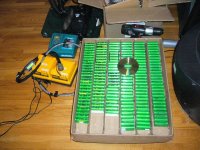Doctorbass
100 GW
. == 2100Wh 432 kinion cells project ==
In the last weeks, i have been talking alot about a new pack made of cells that i got from the 50 lasts Makita pack 3Ah 18V (the Konion)
In this post, i would like to share you the developpment of that big battery pack.
Why doing it?:
There are two mains reasons why i decided to built this pack. the main is that i had acces to many free deffective/used makita pack that i want to give a second life. Each of these pack have generaly 75% of the cells that are great. The service center guys said it's often the first paralleled group of cell that die.
The second reason is a project that i want to accomplish on the next summer. I would like to make a trip of 210km (no predaling) to go to visit some memorable people in my College at La Pocatière in the east of Quebec city. I've calculated that i would need at least 2000Wh to do that.
Why that kind of cell?
Alot of people know me about the dewalt a123 cells. I have been using those from many month and i'm pretty satisfied of those. But they are not the only one. They are made by Sony and are called Konion cell. They are labled US 18650V.. mostly 18650V. After finding alot of info about those on some RC forum and some german website, i discovered that they have multiple avantages. They are SAFE.. no explosion, fire.. etc. their rating are:
-3.7V (charge to 4.2V max 3C)
-1600mAh
-10C
-800+cycle life
-30mohm
-NO NEED OF BALANCING!
They have advantages close to the A123 but they no need Balancing!
Let's go back in time:
In the begining of september I began to rassemble the Makita pack and i began to dissassemble those. Curiously they use the same t-10 screw than the dewalt pack each days, the dissassembling of these pack become easier and faster. For every pack i needed to remove the dust, wood/metal particules, the thermal protection circuit, wires and finally removing the bad cells after measuring their voltage.
each days, the dissassembling of these pack become easier and faster. For every pack i needed to remove the dust, wood/metal particules, the thermal protection circuit, wires and finally removing the bad cells after measuring their voltage.
Most of the time, the voltage of the bad(s) cell(s) was 0.000.. so that is evident to find.
In mid-september, i began to charge fully each cells. The pack are made of 5s 2p cells and after removing the bad 1s2p group i precharged each 1s2p to 4.2V until they reach the 100mA cuttoff (50mA per cell). I choosed to charge each 1s2p group independently instead of charging each 4s2p to 16.8V to avoid problem in case where the capacity of one 1s2p of the 4s2p could have decreased and resulting in a prematured imbalance. It toke several hour to charge !! Let's say around 1h per 2 cells at 3hour a day after the job.. during the weekend...
In october, i began to use my RC charger (The MegaPower 960-SR) A very complete battery charger and analyzer ! Due to the very variable cycle life and past life conditions of each 18V Makita pack , i absolutly need to match perfectly all the cells to create all the parallel group that will be put in serie. To make the caracterisation of each cells i need to measure the internal resistor and the capacity of each cell. A VERY VERY VERY LONG JOB TO DO !!
Today, I have 122 cells out of 360 that are fully measured. I should finish that between January and February.
I have not completly decided what should be the final configuration of the battery pack. That will depend on what speed i will decide to use during the travel of 210km. I would like a tradeoff between a decent speed to have fun during this trip, and not too much to avoid getting a poor milleage (wh/km). i am thinking about a 74V/27Ah (20s18p) or maybe 60v33Ah (16s22p)
The Cells matching
This afternoof at my job, i meet my good friend Eric that is a good programmer (mathlab, vis basic, c++..etc) and we discussed to a great and fast way to calculate the best cells matching. He could create for me a software that calculate all the hard and long stuff for me.
The goal about that will be to get the same total capacity and internal resistor between each parallel groups (the 18p or 22p).
I found that the internal resistor have no a defined and precise relationship with capacity, so i need to take account of each of the two value of each cell.
We have been think about a way to give a single value for each cells to facilitate the calculation for the matching that cold be like a energy value or a rate value.
Normally, the best cell should have:
-a high capacity
-a low internal resistor
Both of these value can be convereted into one unique value.
But how?
Maybe the Wh value is a direct and proportionnel result of that...?
In this case i could only match each group to get the same Wh... that would be easy..
Maybe i can't...
Tonight i'm testing 5 of the tested cells that have the same mAh value but that have different internal resistance.
I would try to findout if their Wh can be proportional with the internal resistance or not.
Normally, i assume that the higher the internal resistor, the higher we get the heat loss during discharging or charging. I expect that this will be revelated with these test and that the cells with lower internal resistor will have less wh.
What is difficult is to measure the thrue internal resistance because in my lab, if the temperature change, the internal resistance change too ! ! so i need to wait until the temp become stable since i comeback from the job and the electronic thermostat rise the temp at 16h and get stabilised at around 18h30...
That's the part i'm working now.
I hope to get the answer for tomorrow.
Doc
In the last weeks, i have been talking alot about a new pack made of cells that i got from the 50 lasts Makita pack 3Ah 18V (the Konion)
In this post, i would like to share you the developpment of that big battery pack.
Why doing it?:
There are two mains reasons why i decided to built this pack. the main is that i had acces to many free deffective/used makita pack that i want to give a second life. Each of these pack have generaly 75% of the cells that are great. The service center guys said it's often the first paralleled group of cell that die.
The second reason is a project that i want to accomplish on the next summer. I would like to make a trip of 210km (no predaling) to go to visit some memorable people in my College at La Pocatière in the east of Quebec city. I've calculated that i would need at least 2000Wh to do that.
Why that kind of cell?
Alot of people know me about the dewalt a123 cells. I have been using those from many month and i'm pretty satisfied of those. But they are not the only one. They are made by Sony and are called Konion cell. They are labled US 18650V.. mostly 18650V. After finding alot of info about those on some RC forum and some german website, i discovered that they have multiple avantages. They are SAFE.. no explosion, fire.. etc. their rating are:
-3.7V (charge to 4.2V max 3C)
-1600mAh
-10C
-800+cycle life
-30mohm
-NO NEED OF BALANCING!
They have advantages close to the A123 but they no need Balancing!
Let's go back in time:
In the begining of september I began to rassemble the Makita pack and i began to dissassemble those. Curiously they use the same t-10 screw than the dewalt pack
Most of the time, the voltage of the bad(s) cell(s) was 0.000.. so that is evident to find.
In mid-september, i began to charge fully each cells. The pack are made of 5s 2p cells and after removing the bad 1s2p group i precharged each 1s2p to 4.2V until they reach the 100mA cuttoff (50mA per cell). I choosed to charge each 1s2p group independently instead of charging each 4s2p to 16.8V to avoid problem in case where the capacity of one 1s2p of the 4s2p could have decreased and resulting in a prematured imbalance. It toke several hour to charge !! Let's say around 1h per 2 cells at 3hour a day after the job.. during the weekend...
In october, i began to use my RC charger (The MegaPower 960-SR) A very complete battery charger and analyzer ! Due to the very variable cycle life and past life conditions of each 18V Makita pack , i absolutly need to match perfectly all the cells to create all the parallel group that will be put in serie. To make the caracterisation of each cells i need to measure the internal resistor and the capacity of each cell. A VERY VERY VERY LONG JOB TO DO !!
Today, I have 122 cells out of 360 that are fully measured. I should finish that between January and February.
I have not completly decided what should be the final configuration of the battery pack. That will depend on what speed i will decide to use during the travel of 210km. I would like a tradeoff between a decent speed to have fun during this trip, and not too much to avoid getting a poor milleage (wh/km). i am thinking about a 74V/27Ah (20s18p) or maybe 60v33Ah (16s22p)
The Cells matching
This afternoof at my job, i meet my good friend Eric that is a good programmer (mathlab, vis basic, c++..etc) and we discussed to a great and fast way to calculate the best cells matching. He could create for me a software that calculate all the hard and long stuff for me.
The goal about that will be to get the same total capacity and internal resistor between each parallel groups (the 18p or 22p).
I found that the internal resistor have no a defined and precise relationship with capacity, so i need to take account of each of the two value of each cell.
We have been think about a way to give a single value for each cells to facilitate the calculation for the matching that cold be like a energy value or a rate value.
Normally, the best cell should have:
-a high capacity
-a low internal resistor
Both of these value can be convereted into one unique value.
But how?
Maybe the Wh value is a direct and proportionnel result of that...?
In this case i could only match each group to get the same Wh... that would be easy..
Maybe i can't...
Tonight i'm testing 5 of the tested cells that have the same mAh value but that have different internal resistance.
I would try to findout if their Wh can be proportional with the internal resistance or not.
Normally, i assume that the higher the internal resistor, the higher we get the heat loss during discharging or charging. I expect that this will be revelated with these test and that the cells with lower internal resistor will have less wh.
What is difficult is to measure the thrue internal resistance because in my lab, if the temperature change, the internal resistance change too ! ! so i need to wait until the temp become stable since i comeback from the job and the electronic thermostat rise the temp at 16h and get stabilised at around 18h30...
That's the part i'm working now.
I hope to get the answer for tomorrow.
Doc






